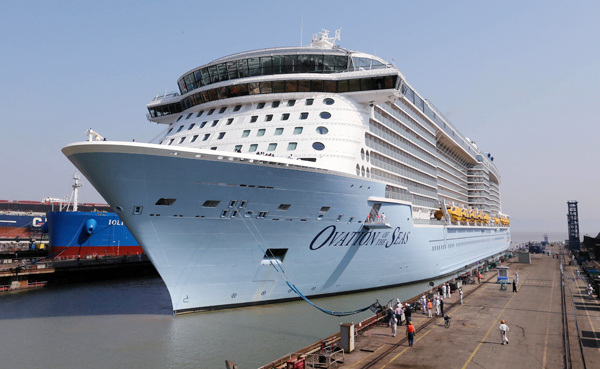 A cruise ship enters a shipyard in Zhoushan, Zhejiang province, for maintenance in April. The first cruise liner to be built in China is expected to be delivered in 2023. (Shen Lei / For China Daily) Editor's note: In the run-up to the 19th National Congress of the Communist Party of China, China Daily will cover a series of key projects and advanced equipment of national importance, showcasing the country's huge improvements and relentless efforts in manufacturing upgrading and innovation. Historic vessel, costing estimated $1 billion, will be delivered to HK buyer in 2023 The first cruise liner to be built in the Chinese mainland is expected to be delivered to a Hong Kong-based buyer in 2023, marking a significant milestone in the evolution of the nation's shipbuilding industry. It is also expected to boost a plethora of supplier segments as well as domestic tourism, experts said. The vessel will be used in the Chinese market. The as-yet unnamed ship will be built at Waigaoqiao, Shanghai, by a joint venture between the State-owned China State Shipbuilding Corp and Italy-based Fincantieri SpA, the world's largest cruise shipbuilding company. There is no official word on the cost and cost advantages, if any, compared to European shipbuilders that dominate the industry. But Chen Gang, vice-president of Waigaoqiao Shipbuilding, a company controlled by CSSC, said he expects the vessel to cost about $1 billion. The cruise ship, reportedly 323.6 meters long and 37.2 meters wide, can hold nearly 5,000 passengers in 2,000 cabins. For perspective, Harmony of the Seas, built by the STX France yard in Saint-Nazaire on the Atlantic coast for US-based Royal Caribbean Cruises Ltd, is regarded as the world's largest cruise ship, according to a London Guardian report. The vessel, which cost close to $1 billion, has 16 decks and can carry 6,360 passengers and 2,100 crew members. According to Wu Qiang, general manager of CSSC, the China-made vessel will be the first of five to be delivered on a yearly basis from 2023 onward. Wu Zhenglian, a cruise ship design expert with CSSC's research institute, said, "The vessel is the outcome of a decade of efforts by the Chinese shipbuilding industry to satisfy the rising demand for water-based travel among the country's humongous and upwardly mobile middle class." Some 2.1 million Chinese tourists traveled in cruise liners in 2016, taking the third position in the annual global passenger rankings, according to data from the Cruise Lines International Association. The rise to the third spot took over a decade. China's cruise economy took off in 2006, posting about 45 percent compound annual growth rate ever since. Building homegrown cruise ships is part of the natural evolution of the industry, observers said. Currently, Italy, Germany and France dominate the world's luxury cruise shipbuilding sector. In all, they make and deliver eight large cruise ships per year, lagging the world's demand for 13 ships. This is where CSSC sees future potential. In October 2015, it signed an agreement with China Investment Corp, the Chinese sovereign wealth fund, and Carnival Corp & Plc, the world's largest leisure travel company with global operations, to form a joint venture in Hong Kong. The latter will place orders with the CSSC-Fincantieri joint venture for cruise ships. In February, Carnival announced the Hong Kong company had signed an agreement to order the first-ever cruise ship to be built in the Chinese mainland. The Hong Kong company will order two new liners from the CSSC-Fincantieri joint venture. It has an option to order four more home-built ships. The construction of China's first cruise ship will help improve various sectors of the domestic shipbuilding ecosystem, said Chen of Waigaoqiao. According to Wu Zhenglian, in spite of China's strength in building other types of vessels, the construction of a cruise ship would be a new experience as it has special requirements in craftsmanship, quality and other specifications. Preparation for the project began in 2014. The design of the vessel would need at least 1 million man-hours. The construction requires more than 3,000 skilled workers with professional education and technical knowledge, according to Chen. Wu Zhenglian said the building process of the first two vessels would need extra time as it involves professionals from different cultures, who may take some time to learn to work together. That also presents a great opportunity for Chinese manufacturers to gather experience of multicultural workplaces and learn foreign shipbuilding techniques. To meet the stiff deadline and avoid any time overrun that would result in huge losses, the shipbuilder needs to access a global supply chain as well as a network of domestic suppliers that can provide high-quality components, Wu said. |
Powered by Discuz! X3.4
© 2001-2013 Comsenz Inc.